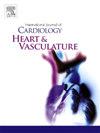Impact of renin-angiotensin system targeted therapy on aortic elastic properties assessed by computed tomography
IF 2.5
Q2 CARDIAC & CARDIOVASCULAR SYSTEMS
引用次数: 0
Abstract
Background
Aortic stiffening is a well-known cardiovascular risk factor. Computed tomography (CT) has proven to be a valuable tool in the assessment of aortic elastic properties. Drugs that inhibit the renin-angiotensin system (RAS) play a central role in cardioprotective therapy. We aimed to evaluate the relationship between aortic elastic properties and RAS-targeted therapy in hypertensive patients.
Methods
This is an observational prospective study of hypertensive patients with nonobstructive coronary artery disease who underwent coronary CT angiography (CCTA). Aortic compliance and distensibility were calculated from the ECG-gated CCTA image. Patients were divided into two groups − those with RAS-targeted therapy − RAS(+) and those with non-RAS-targeted therapy − RAS(−). The elastic properties of the aorta were compared between the two groups.
Results
A total of 142 patients were included in the final analysis. 53.5 % of the population were in the RAS(+) group and 46.5 % in the RAS(−) group. Elastic properties of ascending and descending aorta were significantly higher in the RAS(+) group compared to the RAS(−) group: AA compliance 1.42 ± 0.75 mm2/mmHg in the RAS(+) vs 1.03 ± 0.91 mm2/mmHg in the RAS(−), p = 0.024; AA distensibility 2.86 ± 1.11 x10-3mm3 in the RAS(+) vs 1.82 ± 0.97 x10-3mm3 in RAS(−), p < 0.001; DA compliance 1.45 ± 1.10 mm2/mmHg in the RAS(+) vs 1.11 ± 0.91 mm2/mmHg in the RAS(−), p 0.031; DA distensibility 2.35 ± 0.84 x10-3mm3 in the RAS(+) vs 1.73 ± 1.21 x10-3mm3 in RAS(−), p < 0.001. There was an excellent correlation between RAS therapy and ascending aorta compliance and distensibility (r = 0.901, p < 0.001 and r = 0.875, p < 0.001, respectively).
Conclusion
Patients receiving RAS-blocking treatment revealed significantly higher compliance and distensibility of ascending and descending aorta. In addition, aortic elastic properties were significantly correlated with the RAS-targeted therapy.
通过计算机断层扫描评估肾素-血管紧张素系统靶向疗法对主动脉弹性特性的影响
背景主动脉僵化是众所周知的心血管风险因素。计算机断层扫描(CT)已被证明是评估主动脉弹性特性的重要工具。抑制肾素-血管紧张素系统(RAS)的药物在心脏保护治疗中发挥着核心作用。我们旨在评估高血压患者主动脉弹性特性与 RAS 靶向治疗之间的关系。方法这是一项前瞻性观察研究,研究对象是接受冠状动脉 CT 血管造影术 (CCTA) 的非阻塞性冠状动脉疾病高血压患者。主动脉顺应性和扩张性由心电图门控 CCTA 图像计算得出。患者被分为两组--接受 RAS 靶向治疗的患者(RAS(+))和非 RAS 靶向治疗的患者(RAS(-))。两组患者主动脉的弹性特性进行了比较。RAS(+)组占 53.5%,RAS(-)组占 46.5%。与 RAS(-)组相比,RAS(+)组患者升主动脉和降主动脉的弹性特性明显更高:RAS(+)组 AA 顺应性为 1.42 ± 0.75 mm2/mmHg vs RAS(-)组为 1.03 ± 0.91 mm2/mmHg,p = 0.024;RAS(+)组 AA 伸缩性为 2.86 ± 1.11 x10-3mm3 vs RAS(-)组为 1.82 ± 0.97 x10-3mm3,p < 0.001;RAS(+)的DA顺应性为1.45 ± 1.10 mm2/mmHg vs RAS(-)的1.11 ± 0.91 mm2/mmHg,p 0.031;RAS(+)的DA扩张性为2.35 ± 0.84 x10-3mm3 vs RAS(-)的1.73 ± 1.21 x10-3mm3,p <0.001。结论接受 RAS 阻断治疗的患者升主动脉和降主动脉的顺应性和扩张性显著提高。此外,主动脉弹性特性与 RAS 靶向治疗有明显相关性。
本文章由计算机程序翻译,如有差异,请以英文原文为准。
求助全文
约1分钟内获得全文
求助全文
来源期刊

IJC Heart and Vasculature
Medicine-Cardiology and Cardiovascular Medicine
CiteScore
4.90
自引率
10.30%
发文量
216
审稿时长
56 days
期刊介绍:
IJC Heart & Vasculature is an online-only, open-access journal dedicated to publishing original articles and reviews (also Editorials and Letters to the Editor) which report on structural and functional cardiovascular pathology, with an emphasis on imaging and disease pathophysiology. Articles must be authentic, educational, clinically relevant, and original in their content and scientific approach. IJC Heart & Vasculature requires the highest standards of scientific integrity in order to promote reliable, reproducible and verifiable research findings. All authors are advised to consult the Principles of Ethical Publishing in the International Journal of Cardiology before submitting a manuscript. Submission of a manuscript to this journal gives the publisher the right to publish that paper if it is accepted. Manuscripts may be edited to improve clarity and expression.
 求助内容:
求助内容: 应助结果提醒方式:
应助结果提醒方式:


